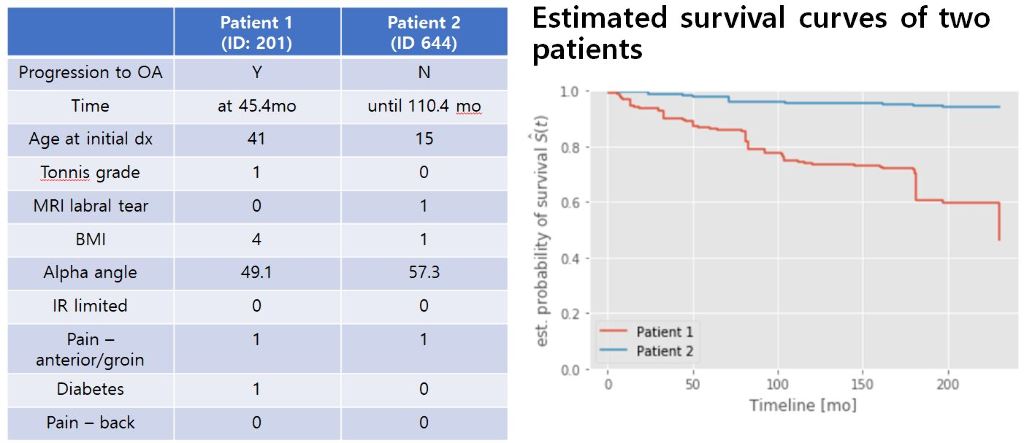12.3.4 - Patient-Specific Survival Prediction of Osteoarthritis in Hip Femoroacetabular Impingement Patients Using Machine Learning
- A. Pareek (Rochester, US)
- A. Pareek (Rochester, US)
- S. Ko (Seoul, KP)
- C. Jo (Seoul, KP)
- D. Ro (Seoul, KR)
- A. Krych (Rochester, US)
Abstract
Purpose
The purpose of this study is (1) Predict survival curve of progression to OA for individual Hip FAI patient with machine learning algorithm and (2) compare performance of machine learning-based survival model and conventional Cox proportional hazard (CPH) model.
Methods and Materials
Between 2000 and 2016, all patients diagnosed with FAI in the Rochester Epidemiology Project were reviewed. Total of 1,012 patients with a mean age of 28.5 years were included. Demographics, physical exam, imaging features were included. The patient’s data was randomly split into Train (70%) and test (30%) sets.
Random survival forest (RSF), a non-parametric tree-based survival model is used to assess survival curves for individual patient. Concordance probability (C-index), the pairwise probability of lower patient risk given longer survival time, was used for evaluation.
Results
Of 1,012 patients, 90 (8.9%) progressed to OA over an average follow-up of 63.6 months. The average follow-up for non-OA patients is 95.4 months. There were no statistically significant survival differences between train and test set. Of the 37 variables, 9 variables were initially selected by univariate analysis. The selected features were – Age, Tonnis grade, MRI labral tear, Body mass index (BMI), alpha angle, limitation of internal rotation, anterior/groin pain, diabetes, and back pain. C-index of RSF model was 0.887 in train set and 0.845 in test set. While C-index of CPH model was 0.836 (train) and 0.840 (test). Figure 1 shows feature importance of RSF model. Survival curves for individual patients were created and tested for survival prediction in an online calculator (Figure 2).


Conclusion
With random survival forest model, individual survival curves can be assessed to discuss progression of hip osteoarthritis with patients. Age, MRI labral tear and Tonnis grade at initial presentation were most important three factors for osteoarthritis progression.